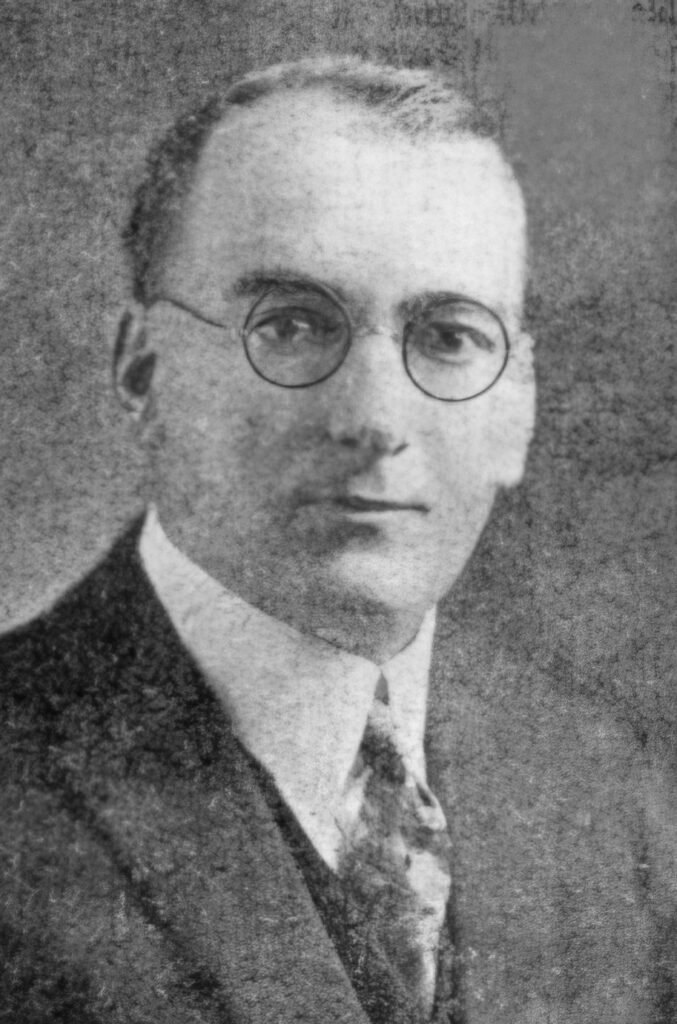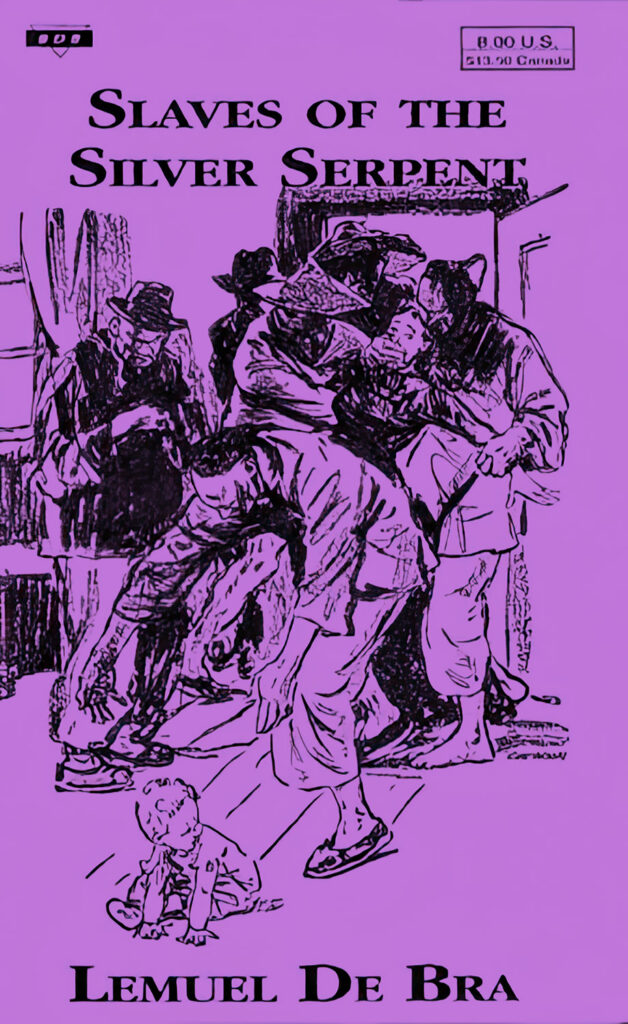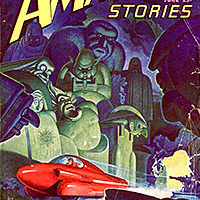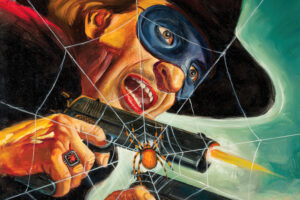
The title and cover artwork really didn’t grab me. In fact, my first thought is that it was another reprint of spicy pulp stories, which I don’t care for. But I picked it up anyway and flipped through it. The titles of the stories didn’t do much for me either. Then I noticed that they all came from Blue Book in 1922. As a top-tier pulp, these were clearly not spicy stories. They were instead stories of Oriental intrigue by an author I had never heard of.
In the back was a brief overview of the author, with only a little information on him, but I was impressed that he apparently wrote not only a lot for Blue Book, but also for Short Stories and Clues, and also did Westerns and other mysteries for a variety of pulps, many of them the better ones like Argosy, All-Story, and Complete Stories.
Looking around, I found that Black Dog Books had done a second chapbook, Tribe of the Tiger (2004), and ordered it. It had a single work, a novella from February 1934 (not 1940 as the chapbook claims). This is another Oriental intrigue story. And it included the same single page of info on the author. Other than a couple of books reprinted during the author’s lifetime and a couple of short stories in recent years, I am not aware of any other of his works being reprinted.
Who is Lemuel de Bra? Well, at first all I had to go by is what Tom Roberts found and wrote in the back of these two books. I did some searching online and at first, I didn’t find much more than that. He was born in 1884 (in Iowa) and died in 1954 (in Pensacola, Fla.). I found his gravesite, and it showed his name as “de Bra” not “De Bra,” and he was buried with his wife and his son Lemuel Warren de Bra (1915-63). I wanted to learn more because I was suspicious of his government service. While many pulp writers used their real-life experiences in writing their stories, for every one who does that, there are several who just made it all up, and often then claimed such experiences.
Finally found an online copy of an article on him from the Oakland Tribune (Sept. 23, 1923, p. 87), which indicated he had recently moved to Florida. He states that in 1907 he entered government service working for the IRS instead of going to college, and three years later left when his writing income matched his government one.
If he was writing for the pulps, most likely this was under an unknown pseudonym, as his first pulp work was in 1919. Or he wrote other works.
His next job was publicity for four-and-a-half years, during which he wrote five boy’s adventure novels for Street & Smith as Edmond Lawrence. Next, he went back as a narcotics agent. Clearly this government work, mostly in California, where he was involved in opium and drug cases in Chinatown, gave him the knowledge for his stories.
After that first pulp work in 1919, he took a year’s leave to write more. And in 1922 left California (and government work?) and drove to Florida. He would later move to other states for a while before moving to Pensacola, where he would pass away, along with his wife and soon after his son and daughter-in-law.
Thanks to info provided by James Keeline, I was able to fill in some holes in his life, but still had no idea of his writing career before the pulps.
From checking the indexes at Galactic Central, his pulp career started in 1919 in Blue Book, where he wrote extensively for the next couple of years with a couple of works in The Popular Magazine. As noted, most of his early works were Oriental intrigue, but he soon got into Western stories, and later detective stories.
He wrote 77 stories in Blue Book, 26 stories in Clues (along with 26 articles in Clues), and almost 20 stories in Short Stories. And he often had two to three stories a month in different magazines, with maybe also an article in the ’20s, but started to slow down in the ’30s.
He stopped writing for the pulps around 1941. I don’t know if he had works in the slicks. I did discover an article in Scientific American in 1918. He may have been writing non-fiction pieces as well. As noted, Galactic Central listed several articles in Clues.
He had two books published during his lifetime. Doubleday’s Garden City Press reprinted one of his longer Western works from Aces-High as #54 in their series of “Red Disc” reprints (so-called as they used the covers from Short Stories, also owned by Doubleday, which always had a red disc on them): Bandit of Devil’s Own (1924). It’s about a customs officer working at the US-Mexico border dealing with smugglers and outlaws.
And the second was a collection of a dozen Chinatown mysteries from Short Stories and Popular Magazine: The Ways That Are Wary (1925). In addition to the two Black Dog chapbooks, Wildside Press has made available a couple of his stories in ebook format on Amazon and reprinted one of those in Adventure Tales #7.
 Let’s take a look at the two Black Dog Books chapbooks. Both include the interior artwork that appeared with the stories. First up is Slaves of the Silver Serpent (2002) that reprints four stories from Blue Book:
Let’s take a look at the two Black Dog Books chapbooks. Both include the interior artwork that appeared with the stories. First up is Slaves of the Silver Serpent (2002) that reprints four stories from Blue Book:
- “The Curse of Hui Pa’o,” April 1922
- “Slaves of the Silver Serpent,” March 1922
- “The House of Drooping Wreaths,” February 1922
- “The Kang-he Poison Jar,” August 1928
“The Curse of Hui Pa’o” gives us a Chinese tale about a river pirate and a virtuous maiden. And a curse on the Yellow River that brings about the pirate’s end. I have no idea if this is a real tale from China or one made up. “Slaves of the Silver Serpent” is a darker tale, of a young couple hoping to marry who get tied up in the opium dens of Chinatown.
“The House of the Drooping Wreaths” is also set in Chinatown, but it is about Squadman Darrow who must deal with murder in one of them. “The Kang-he Poison Jar” is set in Shanghai, and is about a pair of rivals who seek out Chinese porcelain to sell to collectors overseas: Jim Eldreth and Hobe Witherill. But Witherill isn’t as honest and often has replicas made. Eldreth is after the title jar, and Witherill plans with a Chinese to rip him off. Will they succeed?
It’s an interesting collection of stories. I actually more enjoyed the first and last stories. The pair set in Chinatown opium dens didn’t appeal to me much. But all were well written in my estimation. I would be interested in reading more of his stories.
Next is Tribe of the Tiger (2004), which as I noted reprints the title novella from February 1934. It’s supposedly part of a “Secret Service” series that is only two stories. The other is “The Diamond Necklace” from Blue Book in October 1932. I’m not sure of the connection, and suspect most likely the main characters appeared in both.
The backdrop for “Tribe” is that a representative from China is coming to the U.S. to ask for help from the State Department. An expert on the Orient, Professor Joseph Enslow, will be that go-between for the two governments. But sinister forces want to stop this and have enlisted a Chinese secret society called “The Tribe of the Tiger” to waylay Enslow and replace him with another in San Francisco. Worse, they plan some atrocity in D.C. that will cause relations to China to be severed.
Enter our heroes: Secret Service freelancer Jim Shannon along with his daughter, Lolo, who is known as “Miss Secret Service.” We don’t often get female protagonists, so this will be interesting. Jim is described as “portly” and “middle-aged,” so hardly the man of action we expect.
We soon meet the other players in this. There is a Dr. Jacobi, a physician who has also contrived to meet Lola. There are: Hurbert Cragmont, a crook and counterfeiter now returned to the U.S.; Yut Doy, who heads the Tribe in the U.S. and runs a roadhouse; Duk Kee, Enslow’s bodyguard and secretary; and Billy Braggs, a Secret Service operative who works with Lola.
Jim and Lola have their work cut out for them: stop the replacement of Professor Enslow, or at least save him, as well as prevent whatever atrocity is planned. Can they succeed?
Based on this, I have to think there is more of his work that is worth reprinting. Maybe not huge volumes, but certainly enough to have a story here and there in magazines, maybe an issue or two of High Adventure or the like.
One story I saw in Clues is titled “Miss Secret Service” and another has “Shannon of the Secret Service.” Do these have the same characters and are there more with them? Could be candidates for reprinting. So if someone has a collection of Clues, they can check them out. I also think that his collection, The Ways That Are Wary could be a good candidate for reprinting.
[An earlier version of this article appeared in From the Den of a Pulp Super-Fan #1 that was included in PEAPS #141.]


